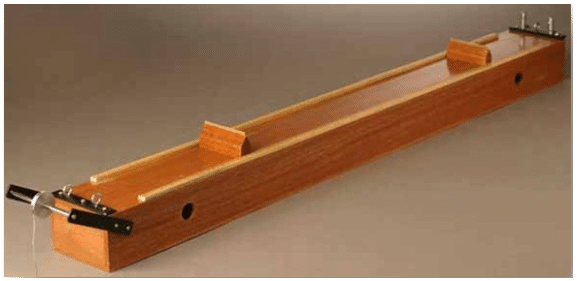Theory & Procedure, Sonometer | Additional Study Material for NEET PDF Download
Objective
- To study the relation between frequency and length of a given wire under constant tension using sonometer. To plot a graph between ν and l.
- To study the relation between length of a given wire and tension for constant frequency using sonometer. To plot a graph between l2 and T.
Theory
What is a Sonometer?
Sonometer consists of a hollow rectangular wooden box of more than one meter length, with a hook at one end and a pulley at the other end. One end of a string is fixed at the hook and the other end passes over the pulley. A weight hanger is attached to the free end of the string. Two adjustable wooden bridges are put over the board, so that the length of string can be adjusted.

Production of transverse waves in stretched strings
If a string which is stretched between two fixed points is plucked at its center, vibrations produced and it move out in opposite directions along the string. Because of this, a transverse wave travels along the string.
If a string of length l having mass per unit length m is stretched with a tension T, the fundamental frequency of vibration f is given by;

Laws of transverse vibrations on a stretched string
- Law of Length: The frequency of vibration of a stretched string varies inversely as its resonating length (provided its mass per unit length and tension remain constant.)

- Law of Tension:The frequency of vibration of a stretched string varies directly as the square root of its tension, (provided its resonating length and mass per unit length of the wire remains constant).

Relation between frequency and length
From the law of length, f ×l = constant
A graph between f and 1/l will be a straight line.
Relation between length and tension
From the equation for frequency, √T / l = constant
A graph between T and l2 will be a straight line.
Learning outcomes
- Students develop the idea about standing waves.
- Students understand the sonometer apparatus and its working.
- Students get the relation between frequency, length and tension of a stretched string under vibration.
Materials Required
- A sonometer
- A set of tuning forks of known frequency
- 0.5kg weight hanger
- Some 0.5kg slotted weights
- Rubber pad
- Paper rider
Real Lab Procedure
To find the relation between frequency and length
- Place the sonometer on the table.
- Make sure that the pulley is frictionless. If you feel any friction, oil them.
- Stretch the wire by placing a suitable maximum load on the weight hanger.
- Move the wooden bridges outward, so that the length of wire between the bridges is maximum.
- Take a tuning fork of known frequency. Make it vibrate by strike its prong with a rubber pad. Bring it near the ear.
- Pluck the sonometer wire and leave it to vibrate.
- Compare the sounds produced by tuning fork and sonometer wire. (Sound which has low pitch has less frequency).
- Gently adjust the bridges for decreasing the length of wire, till the two sounds appear alike.
- Put an inverted V shaped paper rider on the middle of the wire.
- Vibrate the tuning fork and touch the lower end of its handle with sonometer board. The wire vibrates due to resonance and the paper rider falls.
- Measure the length of wire between the bridges using a meter scale. It is the resonant length and record it in the ‘length decreasing’ column.
- Now, bring the bridges closer and then slowly increase the length of the wire till the paper rider falls.
- Measure the length of wire and record it in ‘length increasing’ column.
- Repeat the above steps with tuning forks of other frequencies, and find resonant length each time.
To find the relation between length and tension
- Select a tuning fork of known frequency
- Set the load in the weight hanger as maximum.
- Repeat the steps in the previous section to find out the resonant length.
- Now, remove 0.5kg weight from the weight hanger and find resonant length with same tuning fork.
- Repeat the experiment by removing slotted weights one by one in equal steps of 0.5kg.
- Record the observations each time.
Simulator Procedure (as performed through the Online Labs)
- Select the environment from the drop down list.
- Select the material of the wire from the drop down list.
- Select the diameter of the wire using the slider.
- Select the weight of the slotted weights using the slider.
- Select the frequency of the tuning fork using the slider.
- Click on the ‘Hit tuning fork’ button to start/stop the vibration of tuning fork and touch it with the sonometer board.
- Change the position of bridge A using the slider.
- Change the position of bridge B using the slider.
- Click on the ‘Place the paper rider’ button to place the paper rider back.
- To redo the experiment, click on the ‘Reset’ button.
|
26 videos|312 docs|64 tests
|
FAQs on Theory & Procedure, Sonometer - Additional Study Material for NEET
| 1. What is a sonometer and how does it work? |  |
| 2. What are the applications of a sonometer? |  |
| 3. How is the length of the wire related to the pitch of the sound produced by the sonometer? |  |
| 4. How can the tension in the wire be adjusted on a sonometer? |  |
| 5. What precautions should be taken while using a sonometer? |  |

















